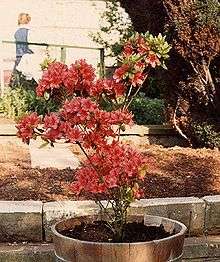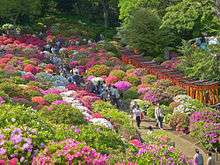Azalea

Azaleas /əˈzeɪliə/ are flowering shrubs in the genus Rhododendron, particularly the former sections Tsutsuji (evergreen) and Pentanthera (deciduous). Azaleas bloom in spring, their flowers often lasting several weeks. Shade tolerant, they prefer living near or under trees. They are part of the family Ericaceae.
Classification
Native American Azaleas
R. occidentale flowers are larger than other azaleas and are usually white with a splotch of yellow, though sometimes are yellow. Can grow to 8 feet.[1]
R. arborescens are native to the east coast of North America and can be found growing wild from Alabama to Pennsylvania in wooded, higher altitude areas. Plants grow up to 20 feet high and flowers are white and fragrant.[1]
The Flame Azalea, R. Native to the mountain regions of Pennsylvania to Georgia and Kentucky. Flowers do not smell but bloom in every shade from pale yellow to crimson red. Flowers bloom in the late spring. A good variety for drier soils and shady areas. Foliage turns bright yellow in the Fall.[1]
Cultivation

Plant enthusiasts have selectively bred azaleas for hundreds of years. This human selection has produced over 10,000 different cultivars which are propagated by cuttings. Azalea seeds can also be collected and germinated.
Azaleas are generally slow-growing and do best in well-drained acidic soil (4.5–6.0 pH).[2] Fertilizer needs are low; some species need regular pruning.
Azaleas are native to several continents including Asia, Europe and North America. They are planted abundantly as ornamentals in the southeastern USA, southern Asia, and parts of southwest Europe.

According to azalea historian Fred Galle, in the United States, Azalea indica (in this case, the group of plants called Southern indicas) was first introduced to the outdoor landscape in the 1830s at the rice plantation Magnolia-on-the-Ashley in Charleston, South Carolina. Magnolia's owner John Grimke Drayton imported the plants for use in his estate garden from Philadelphia, where they were grown only in greenhouses. With encouragement from Charles Sprague Sargent from Harvard's Arnold Arboretum, Magnolia Gardens was opened to the public in 1871, following the American Civil War. Magnolia is one of the oldest public gardens in America. Since the late nineteenth century, in late March and early April, thousands visit to see the azaleas bloom in their full glory.
Disease
Azalea leafy gall can be particularly destructive to azalea leaves during the early spring. Hand picking infected leaves is the recommended method of control.
They can also be subject to phytophthora root rot in moist, hot conditions.[3]
Cultural significance and symbolism
In Chinese culture, the azalea is known as "thinking of home bush" (sixiang shu) and is immortalized in the poetry of Du Fu.
The azalea is also one of the symbols of the city of São Paulo, in Brazil.[4]
In addition to being renowned for its beauty, the azalea is also highly toxic—it contains andromedotoxins in both its leaves and nectar, including honey from the nectar.[5] Azaleas and rhododendrons were once so infamous for their toxicity that to receive a bouquet of their flowers in a black vase was a well-known death threat.[6]
Azalea festivals

Japan
Motoyama, Kochi also has a flower festival in which the blooming of Tsutsuji is celebrated and Tatebayashi, Gunma is famous for its Azalea Hill Park, Tsutsuji-ga-oka. Nezu Shrine in Bunkyo, Tokyo, holds a Tsutsuji Matsuri from early April until early May.
Korea
Sobaeksan, one of the 12 well-known Sobaek Mountains, lying on the border between Chungbuk Province and Gyeongbuk has a royal azalea (Rhododendron schlippenbachii) festival held on May every year. Sobaeksan has an azalea colony dotted around Biro mountaintop, Gukmang and Yonwha early in May. When royal azaleas have turned pink in the end of May, it looks like Sobaeksan wears a pink Jeogori (Korean traditional jacket).[7]
Hong Kong
The Ma On Shan Azalea Festival is held in Ma On Shan, where six native species (Rhododendron championae, Rhododendron farrerae, Rhododendron hongkongense, Rhododendron moulmainense, Rhododendron simiarum and Rhododendron simsii [8]) are found in the area. The festival has been held since 2004; it includes activities such as exhibitions, photo contests and carnivals.[9]
United States
Many cities in the United States have festivals in the spring celebrating the blooms of the azalea, including Summerville, South Carolina; Hamilton, NJ; Mobile, Alabama; Jasper, Texas; Tyler, Texas; Norfolk, Virginia;[10] Wilmington, North Carolina (North Carolina Azalea Festival);[11] Valdosta, Georgia;[12] Palatka, Florida (Florida Azalea Festival);[13] Pickens, South Carolina;[14] Muskogee, Oklahoma; Brookings, Oregon; and Nixa, Missouri.
The Azalea Trail is a designated path, planted with azaleas in private gardens, through Mobile, Alabama.[15] The Azalea Trail Run is an annual road running event held there in late March. Mobile, Alabama is also home to the Azalea Trail Maids, fifty women chosen to serve as ambassadors of the city while wearing antebellum dresses, who originally participated in a three-day festival, but now operate throughout the year.
See also
References
- 1 2 3 New Illustrated Encyclopedia of Gardening: Volume Two. New York, USA: Greystone Press. 1964. pp. 145, 146.
- ↑ Clemson University Factsheet
- ↑ Benson, D.M. "Azalea Diseases in the Landscape". Plant pathology extension NCSU. North Carolina State University. Retrieved 27 January 2011.
- ↑ Municipal law of the city of São Paulo nr. 14472 of 2007.
- ↑ "University of Pennsylvania's Poisonous Plants Home Page". Archived from the original on 2012-03-17.
- ↑ "Stopping to Smell the Rhododendron | Natural Selections". selections.rockefeller.edu. Retrieved 2016-11-02.
- ↑ Department of Culture & Tourism, Danyang-gun County Office
- ↑ "Native Azaleas in Hong Kong" (PDF).
- ↑ "Ma On Shan Azalea".
- ↑ Norfolk NATO Azalea Festival Website
- ↑ North Carolina Azalea Festival Website
- ↑ Valdosta, Georgia, Spring Celebration at Callaway Gardens in Pine Mountain, GA, Azalea Festival Website
- ↑ Palatka, Florida, Azalea Festival Website
- ↑ Pickens' Azalea Festival Website
- ↑ "City of Mobile, Azalea Trail Maps".
External links
| Wikimedia Commons has media related to Rhododendron. |
 "Azalea". Encyclopædia Britannica (11th ed.). 1911.
"Azalea". Encyclopædia Britannica (11th ed.). 1911.- Azalea Society of America
- American Rhododendron Society: What is an Azalea?
- Azalea Collection of the U.S. National Arboretum
- Azalea Collection of Botany garten Pruhonice CZ